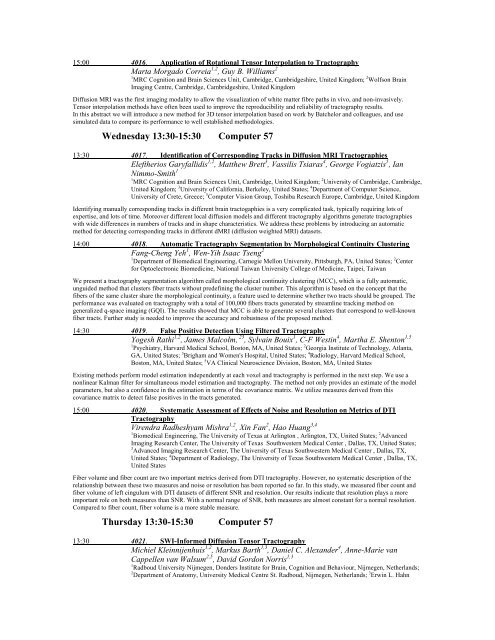ELECTRONIC POSTER - ismrm
ELECTRONIC POSTER - ismrm
ELECTRONIC POSTER - ismrm
Create successful ePaper yourself
Turn your PDF publications into a flip-book with our unique Google optimized e-Paper software.
15:00 4016. Application of Rotational Tensor Interpolation to Tractography<br />
Marta Morgado Correia 1,2 , Guy B. Williams 2<br />
1 MRC Cognition and Brain Sciences Unit, Cambridge, Cambridgeshire, United Kingdom; 2 Wolfson Brain<br />
Imaging Centre, Cambridge, Cambridgeshire, United Kingdom<br />
Diffusion MRI was the first imaging modality to allow the visualization of white matter fibre paths in vivo, and non-invasively.<br />
Tensor interpolation methods have often been used to improve the reproducibility and reliability of tractography results.<br />
In this abstract we will introduce a new method for 3D tensor interpolation based on work by Batchelor and colleagues, and use<br />
simulated data to compare its performance to well established methodologies.<br />
Wednesday 13:30-15:30 Computer 57<br />
13:30 4017. Identification of Corresponding Tracks in Diffusion MRI Tractographies<br />
Eleftherios Garyfallidis 1,2 , Matthew Brett 3 , Vassilis Tsiaras 4 , George Vogiatzis 5 , Ian<br />
Nimmo-Smith 1<br />
1 MRC Cognition and Brain Sciences Unit, Cambridge, United Kingdom; 2 University of Cambridge, Cambridge,<br />
United Kingdom; 3 University of California, Berkeley, United States; 4 Department of Computer Science,<br />
University of Crete, Greece; 5 Computer Vision Group, Toshiba Research Europe, Cambridge, United Kingdom<br />
Identifying manually corresponding tracks in different brain tractogaphies is a very complicated task, typically requiring lots of<br />
expertise, and lots of time. Moreover different local diffusion models and different tractography algorithms generate tractographies<br />
with wide differences in numbers of tracks and in shape characteristics. We address these problems by introducing an automatic<br />
method for detecting corresponding tracks in different dMRI (diffusion weighted MRI) datasets.<br />
14:00 4018. Automatic Tractography Segmentation by Morphological Continuity Clustering<br />
Fang-Cheng Yeh 1 , Wen-Yih Isaac Tseng 2<br />
1 Department of Biomedical Engineering, Carnegie Mellon University, Pittsburgh, PA, United States; 2 Center<br />
for Optoelectronic Biomedicine, National Taiwan University College of Medicine, Taipei, Taiwan<br />
We present a tractography segmentation algorithm called morphological continuity clustering (MCC), which is a fully automatic,<br />
unguided method that clusters fiber tracts without predefining the cluster number. This algorithm is based on the concept that the<br />
fibers of the same cluster share the morphological continuity, a feature used to determine whether two tracts should be grouped. The<br />
performance was evaluated on tractography with a total of 100,000 fibers tracts generated by streamline tracking method on<br />
generalized q-space imaging (GQI). The results showed that MCC is able to generate several clusters that correspond to well-known<br />
fiber tracts. Further study is needed to improve the accuracy and robustness of the proposed method.<br />
14:30 4019. False Positive Detection Using Filtered Tractography<br />
Yogesh Rathi 1,2 , James Malcolm, 23 , Sylvain Bouix 1 , C-F Westin 4 , Martha E. Shenton 1,5<br />
1 Psychiatry, Harvard Medical School, Boston, MA, United States; 2 Georgia Institute of Technology, Atlanta,<br />
GA, United States; 3 Brigham and Women's Hospital, United States; 4 Radiology, Harvard Medical School,<br />
Boston, MA, United States; 5 VA Clinical Neuroscience Division, Boston, MA, United States<br />
Existing methods perform model estimation independently at each voxel and tractography is performed in the next step. We use a<br />
nonlinear Kalman filter for simultaneous model estimation and tractography. The method not only provides an estimate of the model<br />
parameters, but also a confidence in the estimation in terms of the covariance matrix. We utilize measures derived from this<br />
covariance matrix to detect false positives in the tracts generated.<br />
15:00 4020. Systematic Assessment of Effects of Noise and Resolution on Metrics of DTI<br />
Tractography<br />
Virendra Radheshyam Mishra 1,2 , Xin Fan 2 , Hao Huang 3,4<br />
1 Biomedical Engineering, The University of Texas at Arlington , Arlington, TX, United States; 2 Advanced<br />
Imaging Research Center, The University of Texas Southwestern Medical Center , Dallas, TX, United States;<br />
3 Advanced Imaging Research Center, The University of Texas Southwestern Medical Center , Dallas, TX,<br />
United States; 4 Department of Radiology, The University of Texas Southwestern Medical Center , Dallas, TX,<br />
United States<br />
Fiber volume and fiber count are two important metrics derived from DTI tractography. However, no systematic description of the<br />
relationship between these two measures and noise or resolution has been reported so far. In this study, we measured fiber count and<br />
fiber volume of left cingulum with DTI datasets of different SNR and resolution. Our results indicate that resolution plays a more<br />
important role on both measures than SNR. With a normal range of SNR, both measures are almost constant for a normal resolution.<br />
Compared to fiber count, fiber volume is a more stable measure.<br />
Thursday 13:30-15:30 Computer 57<br />
13:30 4021. SWI-Informed Diffusion Tensor Tractography<br />
Michiel Kleinnijenhuis 1,2 , Markus Barth 1,3 , Daniel C. Alexander 4 , Anne-Marie van<br />
Cappellen van Walsum 2,5 , David Gordon Norris 1,3<br />
1 Radboud University Nijmegen, Donders Institute for Brain, Cognition and Behaviour, Nijmegen, Netherlands;<br />
2 Department of Anatomy, University Medical Centre St. Radboud, Nijmegen, Netherlands; 3 Erwin L. Hahn
















